
One-Piece vs Two Piece Toilet – Pros and Cons- 2025 Expert Guide
When upgrading your bathroom, one of the most important—and often overlooked—decisions is choosing between a one-piece or two-piece toilet. While
Whether you own a fiberglass bathtub or a luxurious copper bathtub, cleaning is an essential part of making you and your household happy. If proper upkeep is not maintained in a bathtub, mildew, mold and soap scum will naturally collect on the surface and edges.
This will, of course, result in both health issues as well as rust or deterioration if neglected. Here are some common cleaners, some natural solutions, and a few chemical solutions that will keep your bathtub clean.
Keeping your bathtub clean is not just about aesthetics—it’s about health and longevity. A survey by Apartment Guide revealed that only 38% of Americans clean their bathrooms weekly, while 22% do so monthly, leaving a significant portion of bathtubs prone to the buildup of soap scum, mildew, and mold. Neglecting proper upkeep can lead to health risks and accelerate rust or deterioration, regardless of whether you own a durable fiberglass bathtub or a luxurious copper one. To help you maintain a clean and safe environment, here are some common cleaners, natural solutions, and effective chemical options to keep your bathtub spotless.
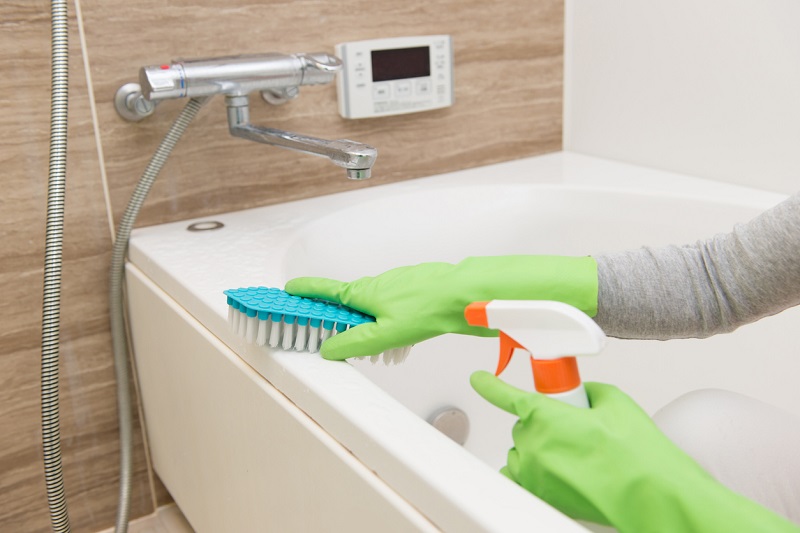
There are many solutions and cleaners out there, all with varying potencies, toxicities, and sizes. Well, which is the best for cleaning your bathtub? Well, ultimately your decision will come down to ease of cleaning, price, and availability of substances.
Baking soda or sodium bicarbonate, in addition to helping with your baked goods also doubles as a decent cleaner for your bathtub. How it works is that baking soda reacts with the grease in stains to form glycerol, a common cleansing agent found in soaps. If it’s mixed with vinegar it also releases carbon dioxide, creating a weak alkali or acid that eliminates strong smells.
Regularly cleaning your bathtub is essential for maintaining a hygienic and pleasant environment. By doing so, you reduce the presence of several potentially harmful or unpleasant substances:
Soap scum forms when soap residue combines with hard water minerals. Over time, it creates a stubborn, filmy layer on the tub’s surface, which can harbor bacteria and leave the bathtub dirty and dull. Regular cleaning prevents its buildup and ensures the tub remains shiny and smooth.
Bathrooms are often humid environments, making them ideal for mold and mildew growth. These fungi can develop around the edges of the tub, in grout lines, or within jets in whirlpool tubs. Beyond being unsightly, mold and mildew can release spores that trigger allergies, respiratory issues, and unpleasant odors.
Hard water leaves mineral deposits, such as calcium and lime, that can accumulate on the tub’s surface. Over time, these deposits form unsightly stains that are difficult to remove if left untreated. Regular cleaning prevents these mineral buildups and keeps the tub looking fresh.
Bathtubs, especially those used frequently, can become a breeding ground for bacteria and germs. Skin cells, oils, and other residues left behind after bathing can encourage the growth of harmful microorganisms, including Staphylococcus aureus and E. coli. Thorough cleaning eliminates these pathogens and ensures a safer bathing experience.
If your bathtub has metal components or the water supply contains high iron levels, rust stains can develop over time. These reddish-brown marks detract from the tub’s appearance and can be difficult to remove if allowed to set.
Bathing naturally leaves behind body oils, sweat, and dead skin cells. Without regular cleaning, these residues can create a slippery film on the tub’s surface, making it unhygienic and potentially dangerous.
After every use, remnants of soap, shampoo, and hair can accumulate in the drain or around the tub’s edges. This buildup can lead to clogged drains and unpleasant smells if not cleaned regularly.
The combination of all the substances mentioned above—soap scum, mold, bacteria, and hair—can create persistent, unpleasant odors. Regular cleaning eliminates the source of these smells, leaving the bathtub and bathroom smelling fresh.
By committing to a regular bathtub cleaning routine, you not only keep your tub looking and smelling great but also create a healthier environment that reduces the risks of skin irritation, allergies, and infections. For the best results, use appropriate cleaning products and tools designed for your bathtub material to avoid damaging the surface while effectively removing grime.
To clean your bathtub, simply sprinkle baking soda on every dirty surface then add warm water. The mixture should begin to bubble and wait about two to three minutes, then begin scrubbing. If you have tough stains, combine your baking soda with either vinegar or ammonia. Your showerhead is a different story. To clean your showerhead, remove it from your shower by turning it counterclockwise. If you cannot remove your showerhead, a clear plastic bag will help.
Head to your sink and grab a large-sized bowl, then combine 3 cups of white vinegar and 1 cup of baking soda. Place the showerhead into the bowl and let it sit for an hour. If your showerhead is extremely dirty, let it sit a bit longer. Scrub and rinse before reinstalling the showerhead.
If you cannot remove your showerhead, fill a plastic bag with a mixture of vinegar and baking soda, then fasten it to your showerhead and let it sit overnight. A similar solution also applies to your drain. You want to dump half a cup of baking soda down the drain with an equal amount of vinegar.
Easy to follow Steps:
Here is how baking soda affects these bathtub materials:
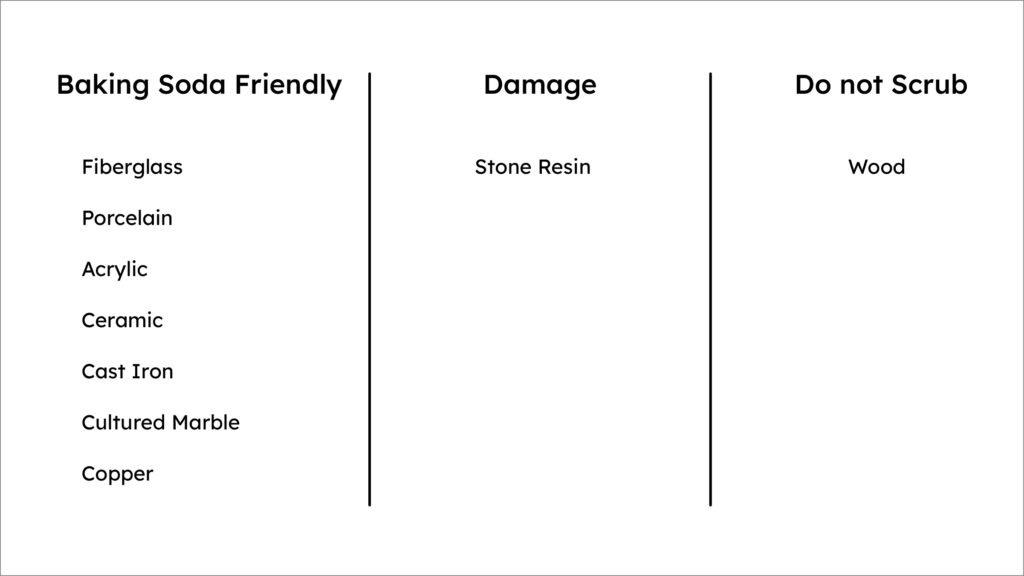
Baking soda is a decent green alternative compared to harsh chemicals, but you certainly do pay for it in other ways. The chemical reaction is a lot slower compared to other leading cleaners, meaning that you have to supplement most of the cleaning with your own muscle and cleaning pad. If you have nothing else in the house and you are trying to be economical, baking soda is a great choice, otherwise other cleaners might be a bit more efficient.
Another natural cleaner, similar to Baking Soda, vinegar or more specifically, white vinegar, cleans by chemical reaction on account of its higher acidity, making it a good cleaner for accumulated soap scum and mildew. Similar to Baking Soda, it will also require a decent amount of labor to get a surface clean.
To clean your bathtub with vinegar, simply mix it with warm water and begin scrubbing the surface of your problem area. If the stain persists, mix vinegar and baking soda and let sit for a few minutes before vigorously scrubbing. Showerheads are much the same. Grab a plastic bag or simply remove your showerhead and submerge it in a baking soda and vinegar solution over night. Drains are the same as baking soda. You want to dump half a cup of baking soda and around half a cup of vinegar in your drain.
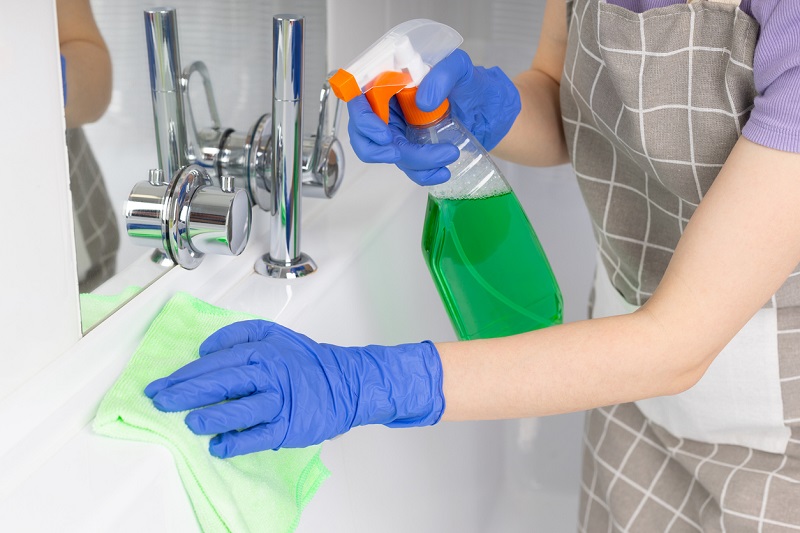
As another natural cleaner, it’s acidity is very useful for removing build up or gunk on tiled surfaces. Anything that has stone or tile surfaces, it also does wonders on

Another natural cleaner, vinegar is useful for cleaning your bathtub if you are shying away from any harsh chemicals. Although it is stronger than baking soda, it shares very similar negatives to it as well. Unless your bathtub is made from stone resin, stone tiles or metal, you actually may want to stay away from both baking soda or vinegar, as the heavy scrubbing from both substances will eventually damage the enamel coating on your bathtub.
Moving out of natural safe cleaners, we have bleach. A highly toxic, strong corrosive substance.
First and foremost, clear out your bathroom of all loofahs, brushes, carpets and rugs before you apply the bleach to your bathtub as it is quite toxic. Now, add about 118 milliliters of bleach to about a gallon of water.
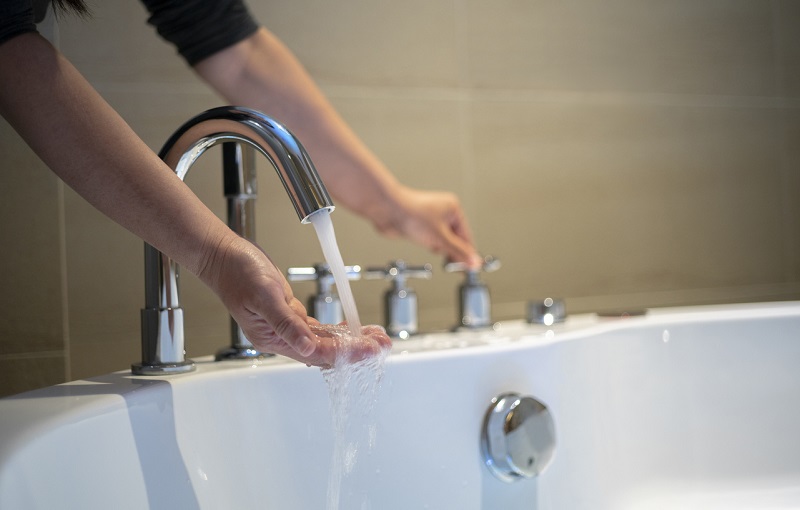
Wear protective gloves, eyewear and a face mask, then dip a sponge and begin scrubbing. Also, you want to be in a well ventilated area and please do not mix bleach with any other household cleaners.
You are going to repeat this method for your showerhead as well, scrubbing it clean with the same sponge that you used to clean your bathtub.
Afterwards, drain your bathtub and wash every surface off with warm water. To clean your drain, simply pour roughly the same amount, about one fourth of a cup in your drain. Though, keep in mind, repeating use of bleach on your drain will lead to long term damages over time.
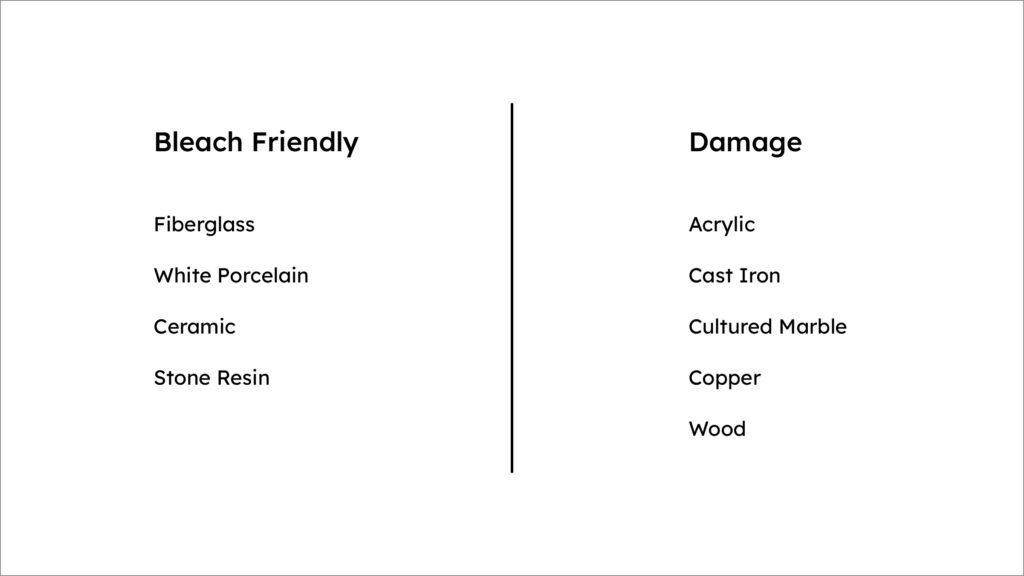
Bleach is a highly effective cleaner. It is also very toxic and hazardous if not used properly. Many would advise using bleach as there are plenty of alternatives, but for ease of access and speed of cutting through nearly all grime and gunk, bleach is unmatched compared to more natural solutions.
Just be safe and well-equipped while using it; otherwise, you may have other issues than a dirty bathtub. There are also other cleaning products such as Comet or Ajax, which contain bleach but are generally less potent than concentrated bleach. These might be more suitable for your cleaning situation and much safer to handle. When cleaning modern freestanding bathtubs, it’s essential to choose products that effectively remove dirt and grime without damaging the tub’s surface, ensuring your bathtub remains in pristine condition.
We will explain the steps required to clean your bathtub to ensure its health and longevity.
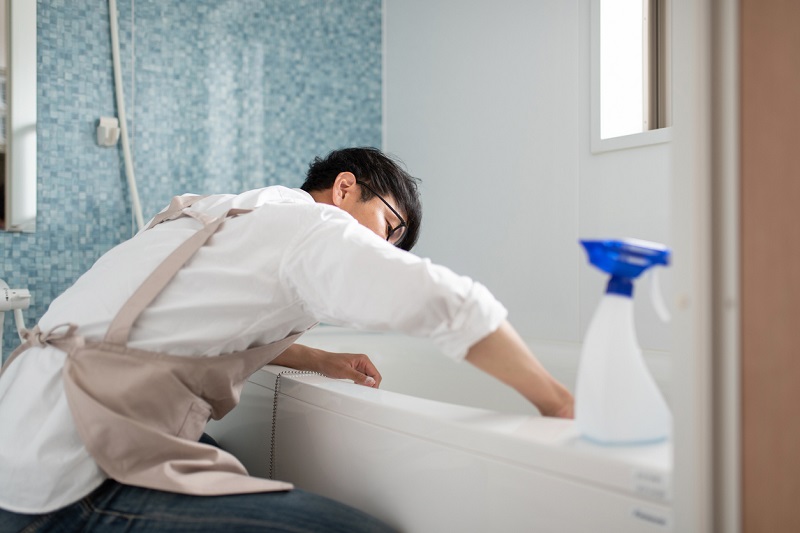

Whether you prefer the natural cleaners to the more heavy chemical side, you have many options today. If you prefer weekly maintenance, natural solutions such as vinegar, lemon and baking soda can do the trick, though if you wait for months without upkeep, bleach can be quite an effective way to restoring your bathtub and bathroom to a more liveable state.
Keeping your bathtub clean and well-maintained doesn’t have to be time-consuming if you follow some simple tips for regular upkeep. Here are some tips to help you maintain a clean bathtub:

Eric is the founder and president of Badeloft USA. He has been the president of Badeloft’s US division for over ten years and oversees all marketing and branding aspects of Badeloftusa.com.
His expertise lies in small business development, sales, and home and bathroom industry trends and information.
Contact us with any business related inquiries.

Free material samples and tub templates

When upgrading your bathroom, one of the most important—and often overlooked—decisions is choosing between a one-piece or two-piece toilet. While

Small details, including what you place on the floor, can make a big difference when setting up or upgrading your

Plumbing traps may seem like small components, but they are critical in keeping your home safe and odor-free. Two of
When shopping for new bath linens, the difference between a bath towel and a bath sheet can feel subtle, but
Request your free material sample below. By submitting, you agree to receive occasional product updates and offers from Badeloft. Unsubscribe anytime.
"*" indicates required fields
"*" indicates required fields
"*" indicates required fields
The vinegar,water and a little Dawn ,and baking soda work wonderful on a fiberglass tub. Also vinegar and water work great on some stains.vingar also works on the yellow stuff that builds up in toilets.
WTH? Who wrote this, first you state…”As such, it is highly recommended that if you have a fiberglass or acrylic bathtub, you should stay away from using baking soda to clean!”
Then go on to list:
Fiberglass: Baking soda friendly
Porcelain: Baking soda friendly
Acrylic: Baking soda friendly..
Uhm…was your intent to confuse or deceive people or do you always talk out of both sides?
It’s been fixed thank you 🙂